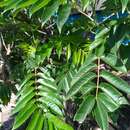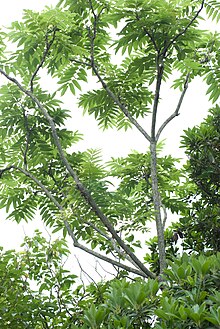fr
noms dans le fil d’Ariane


Zanthoxylum ailanthoides (lat. Zanthoxylum ailanthoides) — sədokimilər fəsiləsinin zanthoxylum cinsinə aid bitki növü.
Zanthoxylum ailanthoides (lat. Zanthoxylum ailanthoides) — sədokimilər fəsiləsinin zanthoxylum cinsinə aid bitki növü.
Zanthoxylum ailanthoides, also called ailanthus-like prickly ash,[1] (Chinese: 椿叶花椒; pinyin: chun ye hua jiao, lit. "Ailanthus-leaved pepper",[2] Chinese: 越椒; pinyin: yue-jiao; Wade–Giles: yüeh-chiao, lit. "Yue pepper",[3] 食茱萸 shi zhu yu,[4][5][6] lit. "edible shān zhū yú"; Japanese: カラスザンショウ, からすのさんしょう[5] karasu-zanshō, karasu-no-sanshō, lit. "crow prickly ash") is an Asiatic plant of the prickly-ash genus Zanthoxylum, natively occurring in forest-covered parts of southeastern China, Taiwan, Southeast Asia, and Japan from Honshu southward.[7] The piquant fruit serves as a local substitute for the ordinary red-pepper in China before the Columbian exchange.[6] In Taiwan, the young leaves are used in cuisines.[3]
Though some refer to the species as "Japanese prickly-ash", that name is confusing since it is sometimes applied to the sanshō which is Z. piperitum. Z. ailanthoides is not normally exploited for human consumption in Japan, except by the prehistoric people from the Jōmon period.[8] It is foraged in the wild by the Japanese macaque.[9]
A regional nickname is tara,[10] and in fact, its young shoots are often mistaken for the true tara (Aralia elata) by gatherers of wild plants.[11] The Latin name ailanthoides of the species comes from its leaves resembling those of the Ailanthus.
Like other genera of plants in the rue family, it serves as the host food plant for the larvae of several Asian swallowtail butterfly species, such as Papilio bianor, Papilio helenus, Papilio protenor, and Papilio xuthus.
Zanthoxylum ailanthoides, also called ailanthus-like prickly ash, (Chinese: 椿叶花椒; pinyin: chun ye hua jiao, lit. "Ailanthus-leaved pepper", Chinese: 越椒; pinyin: yue-jiao; Wade–Giles: yüeh-chiao, lit. "Yue pepper", 食茱萸 shi zhu yu, lit. "edible shān zhū yú"; Japanese: カラスザンショウ, からすのさんしょう karasu-zanshō, karasu-no-sanshō, lit. "crow prickly ash") is an Asiatic plant of the prickly-ash genus Zanthoxylum, natively occurring in forest-covered parts of southeastern China, Taiwan, Southeast Asia, and Japan from Honshu southward. The piquant fruit serves as a local substitute for the ordinary red-pepper in China before the Columbian exchange. In Taiwan, the young leaves are used in cuisines.
Though some refer to the species as "Japanese prickly-ash", that name is confusing since it is sometimes applied to the sanshō which is Z. piperitum. Z. ailanthoides is not normally exploited for human consumption in Japan, except by the prehistoric people from the Jōmon period. It is foraged in the wild by the Japanese macaque.
A regional nickname is tara, and in fact, its young shoots are often mistaken for the true tara (Aralia elata) by gatherers of wild plants. The Latin name ailanthoides of the species comes from its leaves resembling those of the Ailanthus.
Like other genera of plants in the rue family, it serves as the host food plant for the larvae of several Asian swallowtail butterfly species, such as Papilio bianor, Papilio helenus, Papilio protenor, and Papilio xuthus.
Zanthoxylum ailanthoides, es una especie de árbol perteneciente a la familia de las rutáceas. Es originaria de Asia.
Es un árbol de hoja caduca que alcanza un tamaño de 15 m de altura. Las ramillas y el raquis de la inflorescencia son glabras, con espinas. Las hojas tiene 11-27 foliolos; estrechamente lanceolados, pero subovadas las basales en raquis, de 7-18 x 2-6 cm, de color verde grisáceo el envés, con numerosos puntos de aceite, margen crenado, ápice acuminado. Las inflorescencias son terminales, con muchas flores. Pétalos de color blanco amarillento pálido, de 2,5 mm. Semillas de 4 mm de diámetro. Fl. Agosto-septiembre, fr. Octubre-diciembre.[1]
Se encuentra en los matorrales de montaña; a una altitud de 300-1500 metros en Fujian, Guangdong, Guangxi, Guizhou, Jiangxi, Sichuan, Taiwán, Yunnan, Zhejiang en China y en Japón (incluyendo Bonin y las Islas Ryukyu), Corea y Filipinas.
Es el alimento de las larvas de las mariposas Papilio bianor, Papilio helenus, Papilio protenor, y Papilio xuthus.
Zanthoxylum ailanthoides fue descrita por Siebold & Zucc. y publicado en Abhandlungen der Mathematisch-Physikalischen Classe der Königlich Bayerischen Akademie der Wissenschaften 4(2): 138, en el año 1845.[2]
Zanthoxylum ailanthoides, es una especie de árbol perteneciente a la familia de las rutáceas. Es originaria de Asia.
Zanthoxylum ailanthoides (Çince: 椿叶花椒; pinyin: chun ye hua jiao;[1] Japonca: カラスザンショウ, からすのさんしょう karasu-zanshō, karasu-no-sanshō[2]), sedef otugiller (Rutaceae) familyasına ait Güneydoğu Çin, Tayvan, Güneydoğu Asya ve Japonya'nın güneybatısının orman kaplı kısımlarında doğal olarak yetişen bir ağaç türüdür.[3]
Ağacın meyve ve yaprakları Çin ve Tayvan mutfaklarında çeşni olarak kullanılmaktadır.[1]
Zanthoxylum ailanthoides (Çince: 椿叶花椒; pinyin: chun ye hua jiao; Japonca: カラスザンショウ, からすのさんしょう karasu-zanshō, karasu-no-sanshō), sedef otugiller (Rutaceae) familyasına ait Güneydoğu Çin, Tayvan, Güneydoğu Asya ve Japonya'nın güneybatısının orman kaplı kısımlarında doğal olarak yetişen bir ağaç türüdür.
Ağacın meyve ve yaprakları Çin ve Tayvan mutfaklarında çeşni olarak kullanılmaktadır.
Zanthoxylum ailanthoides là thức ăn của ấu trùng Papilio bianor, Papilio helenus, Papilio protenor, và Papilio xuthus.
Zanthoxylum ailanthoides là thức ăn của ấu trùng Papilio bianor, Papilio helenus, Papilio protenor, và Papilio xuthus.
食茱萸(学名:Zanthoxylum ailanthoides),别名红刺楤、红刺葱、大叶刺葱、仁刺葱、刺江某、越椒、毛越椒、鸟不踏等,中國植物誌則稱以椿叶花椒。[1]
食茱萸为芸香科落叶乔木,具有特殊香味。食茱萸的嫩枝密布锐利的尖刺,老幹也长满了瘤状尖刺,连鸟儿也不敢在上面栖息,因此有“鸟不踏”之称。叶片为羽状复叶互生,长30-80厘米,小叶片为披针形,长6-12厘米,边缘有锯齿,小叶密布透明油腺,有芳香味,幼叶常呈红色,故名红刺楤。很多凤蝶幼虫也喜爱吃食茱萸的叶子,为诱蝶植物。食茱萸春季开花,圆锥花序,花小,黄白色。食茱萸是重要的蜜源植物,开花时常吸引许多蝴蝶、蜂类、甲虫等昆虫来前来吸食花蜜,形成“蝴蝶树”的奇特景观。果实于秋季成熟,为蓇葖果,球形,直径0.5-0.6厘米。
食茱萸是药食兼用的本草。
《礼记》中称食茱萸为“藙”,训诂书《广雅》又称为“樾椒”,《本草拾遗》称它为“欓子”。四川先民称它为“艾子”。左思《蜀都赋》曾描述过蜀中”其圃则有蒟蒻茱萸……众献而储。”
果实作药用,有温中、燥湿、杀虫、止痛的功效。
食茱萸是能发出香辛气味的重要调味品。食茱萸古来与花椒、薑并列为“三香”。以四川食物为例,历史上有以下用法:或者将食茱萸果实煎熬成膏状,作牛羊猪肉菜的配料,以除去腥膻味;或者用整粒食茱萸果实作羹臛的调味料;或者用作酒的味料。到明代中叶时,食茱萸已成为四川食物中广泛使用的调味品。《本草纲目》中记载:食茱萸“味辛而苦,土人八月采,捣滤取汁,入石灰搅成,名曰艾油,亦曰辣米油。味辛辣,入食物中用”。明末清初引进了辣椒,古典川菜中的食茱萸就让位于辣椒了。
食茱萸(学名:Zanthoxylum ailanthoides),别名红刺楤、红刺葱、大叶刺葱、仁刺葱、刺江某、越椒、毛越椒、鸟不踏等,中國植物誌則稱以椿叶花椒。
 分類 階級なし : 被子植物 Angiosperms 階級なし : 真正双子葉類 Eudicots 階級なし : バラ類 Rosids 目 : ムクロジ目 Sapindales 科 : ミカン科 Rutaceae 属 : サンショウ属 Zanthoxylum 種 : カラスザンショウ Z. ailanthoides 学名 Zanthoxylum ailanthoides
分類 階級なし : 被子植物 Angiosperms 階級なし : 真正双子葉類 Eudicots 階級なし : バラ類 Rosids 目 : ムクロジ目 Sapindales 科 : ミカン科 Rutaceae 属 : サンショウ属 Zanthoxylum 種 : カラスザンショウ Z. ailanthoides 学名 Zanthoxylum ailanthoidesカラスザンショウ(烏山椒、Zanthoxylum ailanthoides)はミカン科サンショウ属の落葉樹。
サンショウと違ってアルカロイドを含むので、イヌザンショウとともにイヌザンショウ属(Fagara)に入れる場合がある。
学名の「ailanthoides」は、「シンジュ(Ailanthus)のような(-oides)」の意味。
日本のほかに、朝鮮南部、中国、フィリピンなどに分布する。山野に普通に生える。特に伐採跡などの裸地にいち早く伸び出して葉を広げる先駆植物である。
高さは6〜8mで、最大15mになることもある。普通のサンショウに比べて、はるかに大きな葉をつける。サンショウ同様、葉には油点があり、特有の香りがある。花期は7-8月。赤い実をつけて黒い種が露出し、特有の香りを持つ。
葉は1回奇数羽状複葉。葉の形状はニワウルシ/シンジュ(神樹)に似る。
サンショウ属の他の種に比べ、はるかに大きいため、類似種との区別ができる。また、他の大柄な羽状複葉をつける樹木とは、幹の棘と葉のにおいで区別できる。
本種を食草とするチョウにはカラスアゲハ、ミヤマカラスアゲハ、モンキアゲハ、ナミアゲハ、クロアゲハがある。
普通食用にはしないが、若芽・若葉は天ぷらにすることがある。清涼感のある独特の風味の蜂蜜がとれるので、蜜源植物ともされる。また、葉を駆風、果実を健胃薬とし、枝はサンショウ同様すりこぎとしても使用されている。刺部の数が多い事からサンショウの物とは区別ができる。
カラスザンショウ(烏山椒、Zanthoxylum ailanthoides)はミカン科サンショウ属の落葉樹。
サンショウと違ってアルカロイドを含むので、イヌザンショウとともにイヌザンショウ属(Fagara)に入れる場合がある。
学名の「ailanthoides」は、「シンジュ(Ailanthus)のような(-oides)」の意味。
머귀나무(Zanthoxylum ailanthoides)는 한국·일본·중국 등지에 분포하는 낙엽소교목으로 높이 15m까지 자라며, 작은 가지에는 털이 없고 가시가 있다. 잎은 깃모양 겹잎으로 어긋나고 작은잎은 19-23개로 두꺼우며 넓은 바소꼴이고 끝이 날카로우며 잔톱니가 있다. 꽃은 황백색이며 원추꽃차례로 5월에 가지 끝에 피고 우산모양이다. 열매는 삭과로서 공모양이며 11월에 익고 매운맛이 있다. 가시가 없는 것은 민머귀나무(Zanthoxylum ailanthoides var. inermis)라고 하며, 잎자루가 가시에 붉은빛이 도는 것은 좀머귀나무(Zanthoxylum fauriei)라고 한다. 한방에서 잎을 감기와 학질 치료제로 쓴다.